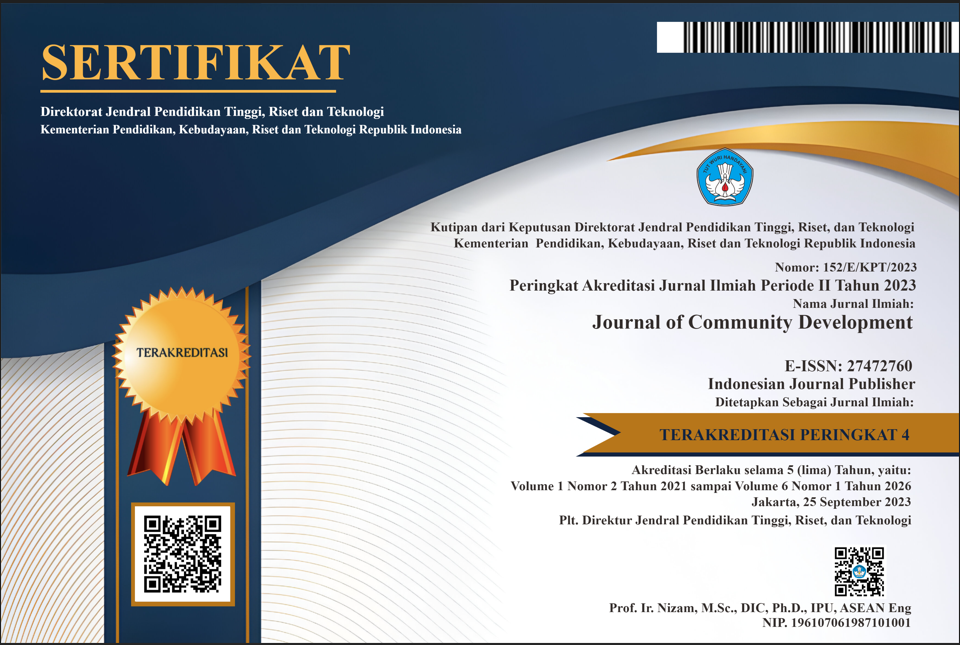Pendampingan Penggunaan Aplikasi Laporan Keuangan BUMDES
DOI:
https://doi.org/10.47134/comdev.v3i3.105Keywords:
bumdes, financial statements, information and communication technology, community dedicationAbstract
Village-Owned Enterprises BUMDES are business entities whose capital is wholly or partly from the village, and the existence of BUMDES is intended to create jobs or improve public services for the community. One indicator of the success of BUMDES is where the administrators who are included in the management organizational structure have understood financial management which at the end of the period will produce correct financial reports. Financial recording is the initial stage in the activity of providing good and correct financial reports, it is necessary to record expenses and income so that all transactions can be known clearly and in detail. By having financial records, even simple ones, all financial flows can be recorded properly, such as the amount of capital that has been used, capital that has not been used, the amount of debt and so on. With the availability of good financial records, the BUMDes can see the development of their business so that the BUMDes management can make plans related to the condition of the BUMDes owned based on the financial records that have been made. The final result of all financial records is the availability of financial statements. The results of this activity are increasing partner insight, especially about financial records that can be used as the basis for detailed and clear BUMDES financial management, as well as increasing partner skills in application-based financial management in the application of recording daily transactions.
Downloads
References
Belfo, F., & Trigo, A. (2013). Accounting Information Systems : Tradition and Future Directions. International Conference on Health and Social Care Information Systems and Technologies (pp. 536 – 546). Procedia.
Dennis, A. d. (2013). Systems Analysis and Design with UML, Edisi 4. New York: John Wiley and Sons.
Hall, J. A. (2009). Sistem Informasi Akuntansi. Jakarta: Salemba Empat.
Indonesia, I. A. (2009). Standar Akuntansi Keuangan. Jakarta: Salemba Empat.
Jember, D. K. (2017). Perubahan Rencana Strategis Tahun 2016-2021. Jember, Jawa Timur, Indonesia.
Kieso, K. W. (2011). Financial Accounting IFRS Edition. John Wiley & Sons, Inc.
Lin, C. Y. (1998). Success Factors of Small and Medium Sized Enterprises in Taiwan An Analysis of Cases. Journal of Small Business Management XXXVI, 43-56.
Lubis, T. A., & Junaidi. (2016). Pemanfaatan Teknologi Informasi pada Usaha Mikro Kecil dan Menengah di Kota Jambi. Jurnal Perspektif Pembiayaan dan Pembangunan Daerah, 163-174.
Nurfriani, V., Paramu, H., & Utami, E. S. (2014). Analisis Kinerja Usaha Mikro, Kecil, dan Menengah (UMKM) Dengan dan Tanpa Pinjaman di Kabupaten Jember. Jember, Indonesia.
Pressman, R. S. (2010). Software Engineering A Practitioner's Approach. New York: McGraw-Hill.
Shagari, S. L., Abdullah, A., & Saat, R. M. (2017). Accounting Information Systems Effectiveness : Evidence From The Nigerian Banking Sector. Interdisciplinary Journal of Information, Knowledge, and Management, 309-335.
Downloads
Published
How to Cite
Issue
Section
License
Copyright (c) 2022 Henny Wahyu Sulistyo, Lutfi Ali Muharom, Hardian Oktavianto, Ardhi Fathonisyam Putra Nusantara

This work is licensed under a Creative Commons Attribution 4.0 International License.







